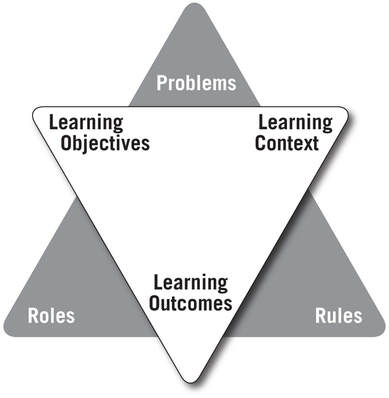The power of role-based e-learning: selected content, tables and figures
Chapter 3 Designing online role plays
- Learner Perspective using Learning Design Sequence
- Educator Perspective using Design Space Framework
- Summary
This is the first of three chapters about the design process. Designing online role play can be a stimulating and exciting experience. These chapters provide detailed and practical insights into design considerations to support development of innovative and original online role plays.
This chapter begins with an overview from the learner’s perspective then considers it from an educator’s perspective.
Two frameworks provide a means of understanding what online role play looks like from each perspective. These are as follows:
Perspective Framework
Learner Learning Design Sequence
Educator Design Space
The Design Space framework, developed specifically for this book, outlines the three elements of the design space: problem, roles and rules. Chapters 4 and 5 examine these three elements in detail.
The other framework, the Learning Design Sequence, was developed for a previous research project, the Learning Designs project.
Table 3.1 Examples of role play tasks from three online role plays
| Role play tasks | |
| File Size: | 32 kb |
| File Type: | doc |
Table 3.2 Example of roles in First Fleet online role play
| Roles | |
| File Size: | 39 kb |
| File Type: | doc |
Table 3.3 Mapping the hierarchy of the colony in First Fleet online role play
| Hierarchy map | |
| File Size: | 33 kb |
| File Type: | doc |
Figure 3.3 The Design Space Framework
Table 3.4 Sample mapping of colony relationships in First Fleet online role play
| Relationships | |
| File Size: | 32 kb |
| File Type: | doc |
Table 3.5 Learning objectives from three online role plays
| Learning objectives | |
| File Size: | 31 kb |
| File Type: | doc |
Summary
An excellent way to gain insight and understanding into the emerging area of role-based e-learning is to experience being a participant in an online role play. Since that is not always possible, this chapter first described the concept of learning design for online role play from the learner’s perspective, looking at the tasks, materials and supports involved.
The second half of the chapter introduced initial design considerations for the educator planning an online role play, covering in brief the three corners of the triangle introduced in Chapter 1: Problems, Roles and Rules.
The next two chapters look at a number of design considerations in more detail.


